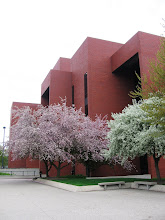The Ball State University Libraries as Third Place after Home and Classroom
 The library as place has been a frequent topic of discussion and scholarship over the past few years. As librarians continue to apply powerful information technologies and to integrate their print and digital collections, their new focus is to design library spaces that attract students who will perceive and use the library as the best place for learning after the classroom.
The library as place has been a frequent topic of discussion and scholarship over the past few years. As librarians continue to apply powerful information technologies and to integrate their print and digital collections, their new focus is to design library spaces that attract students who will perceive and use the library as the best place for learning after the classroom.A discussion of library as place naturally progresses into a deeper inquiry about how people use libraries to solve their informational and research needs as well as how libraries meet our students’ social needs. In Nancy Kalikow Maxwell’s 2006 book, Sacred Stacks: The Higher Purpose of Libraries and Librarianship, she writes that in this time of virtual community, humans need and long for a physical space to gather. In chapter seven, entitled, “Librarians and Libraries Promote Community,” she identifies and promotes libraries as a third place — a place after home and work, with the library as a place that allows people to be in the presence of others to gather informally. In the academic community, these places are the dormitory/home and classroom.
With these first and second places in mind, it is evident that the Ball State University Libraries are fast becoming recognized as the learner’s third place. The number of persons who visit the Ball State University Libraries daily, in all student segments from freshmen through graduate and including faculty, continues to increase. This traffic is measured by turnstile count and data analysis of visitors’ use of our computer workstations, public printing resources, and collection circulation. There are very good reasons why these increases are happening. In part, they are due to the positive experiences and association of our students and faculty as they engage academically and socially in our Libraries.
Our students report that they come to the University Libraries for help from librarians with research papers, to study individually or collaboratively with others, and to use the technologies and software applications that the Libraries make easily accessible. Students speak about the Libraries as a place to read and study, attend a variety of library-sponsored workshops and classes, engage in educational simulation software, or just to be here in the Libraries.
They also mention how they value the Libraries’ popular Bookmark Café as a place where they can grab a cup of coffee or tea, or talk with friends and colleagues. Students see the University Libraries as a place to develop their skills for scholarship and their soft skills that involve community, communication, and creativity. These and other reasons are tangible recognition of the Libraries’ important contribution to the academic community as a learning laboratory and an integral part of campus life.
Libraries, both academic and public, will continue to evolve, adapt, and improve the accessibility of their resources for research, learning, and classroom enhancement. Librarians and the library’s paraprofessional personnel will be found at the forefront of these exciting changes. They will work to expand their library’s collection access and develop new ways for their libraries to contribute to the intellectual pursuits of students and faculty. Libraries will continue to be characterized as providing a rich array of uniformly gracious and friendly services to all users.
In these ways, academic libraries, as a third place, will serve as an extension of the home and classroom, as a laboratory for research and learning, and as a gathering place for academic and social pursuits.
Labels: academic libraries, Ball State University Libraries, third place


0 Comments:
Post a Comment
<< Home